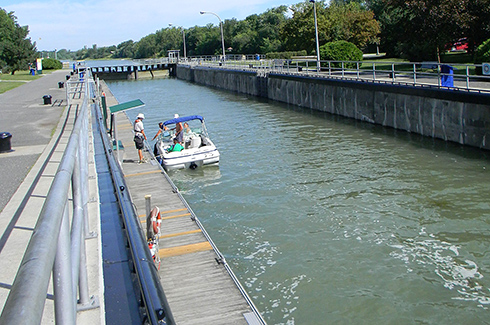
Flowing north from Whitehall, New York to the Canadian border, Lake Champlain finds an outlet in the Richelieu River, which connects to the St. Lawrence River, the Atlantic Ocean, and the wider world. It was by this route that Samuel de Champlain became the first European known to explore the lake that would bear his name.
In the early nineteenth century, Lake Champlain’s place in the region and in the world changed dramatically with ambitious construction projects that would link it to other major water bodies in the nation. Construction of the Champlain Canal, which connects the Lake at Whitehall, New York to the Hudson River, began in 1817. Construction of the Erie Canal, which connects the Hudson to Lake Erie, began at the same time and was completed in 1825. In 1831, work began on the Chambly Canal on the Richelieu River in Quebec.
The canals were a critical element in the economic and industrial growth and westward expansion of the young nation. These connections opened up new corridors of commerce with New York City, Montreal, Québec City, Chicago, and other urban centers, forever changing the economy and culture of much of the Basin. Luxury goods were imported and timber, iron, and other resources were exported. For a period in the mid-1800s, Burlington, Vermont was one of the largest timber ports in the nation.
In time the canals were replaced by railroads and interstate highways as the preferred modes of transport of good and resources. Today, the canals are largely recreational waterways, allowing pleasure boaters to travel by water from Montreal to New York City. An unintended legacy of the canals is the role they play as pathways for the movement of aquatic invasive species, which often hitchhike on these recreational watercraft or swim and float through the aquatic highways that connect watersheds.
The Great Lakes and Hudson River are home to a great number of invasive species that continue to arrive from ports around the world on ocean-going freight ships and pleasure craft. Hydrilla, quagga mussels, round goby and other species have not yet made their way to Lake Champlain, but with direct connections by way of the canals, they pose a significant threat to the ecosystems of the Basin. In response to this threat, the LCBP and other partners in the region have started boat launch steward programs to help prevent the spread of invasive species.



 Lake Champlain Basin Program
Lake Champlain Basin Program